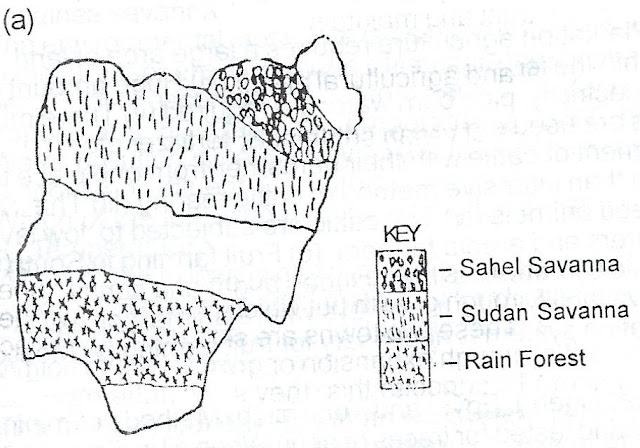NECO Human and Regional Geography (Essay) 2025
Number 1
(1a)
Population refers to the total number of people inhabiting a specific geographic area, such as a country, region, or city, at a given time.
(1b)
(i)Size: Population size is the absolute number of individuals within a defined area. It is a fundamental demographic characteristic and influences resource availability, economic development, and social services.
(ii)Density: Population density measures the number of individuals per unit area (e.g., people per square kilometer or square mile). It indicates how crowded or dispersed a population is within a given space, impacting infrastructure, housing, and environmental pressures.
(iii)Quality: Population quality refers to the characteristics of a population that contribute to its overall well-being and productivity. This includes factors such as health, education levels, skills, and access to resources, which collectively influence a society’s development potential.
(1c)
(i)Health.
(ii)Education.
(iii)Skills and Training.
==================
Number 2
(2a)
(i)Abuja
(ii)Jos
(iii)Lafia
(iv) Ilorin.
(2b)
(i)Economic Growth and Job Creation: Tourism generates revenue through visitor spending on accommodation, food, transportation, and activities, leading to job creation in various sectors like hospitality, transport, and retail.
(ii)Preservation of Culture and Heritage: Tourism encourages the preservation and promotion of cultural sites, traditions, and historical landmarks, as they become attractions for visitors, thereby safeguarding national heritage.
(iii)Infrastructure Development: The growth of tourism often necessitates improvements in infrastructure, such as roads, airports, and utilities, which benefit both tourists and local communities.
(iv)International Relations and Understanding: Tourism fosters cultural exchange and understanding between different nations and peoples, promoting peace and diplomacy.
(2c)
(i)Investment in Infrastructure and Attractions.
(ii)Effective Marketing and Promotion.
(iii)Community Involvement and Empowerment.
(iv)Sustainable Tourism Practices.
==================
Number 3
(3a)
(i)Abundant Raw Materials: Pittsburgh’s location in eastern U.S.A. provided easy access to essential raw materials like coal (from the Appalachian coalfields), iron ore (from the Great Lakes region via water transport), and limestone, which are crucial for steel production the backbone of its industrial growth.
(ii)Excellent Transportation Network: The confluence of the Allegheny, Monongahela, and Ohio Rivers provided natural waterways for transporting raw materials and finished goods. Later, the development of canals and railways further enhanced connectivity to markets and sources of supply, facilitating industrial expansion.
(iii)Skilled Labor Force: The region attracted a large workforce, including immigrants, who provided the necessary labor for the burgeoning industries, particularly in steel manufacturing. Over time, a pool of skilled labor developed, supporting industrial specialization and efficiency.
(iv)Market Access and Demand: Proximity to major urban centers and developing markets in the eastern U.S. provided a ready demand for Pittsburgh’s industrial output, especially steel, which was vital for infrastructure development, manufacturing, and other industries.
(3b)
-Advantages-
(i)Development of Specialized Labor Pool: Concentration of industries in an area leads to the development of a skilled labor force specializing in the industry’s needs, often supported by training institutions.
(ii)Growth of Ancillary Industries and Services: Localization fosters the growth of subsidiary industries (e.g., raw material suppliers, component manufacturers) and specialized services (e.g., banking, transport, communication) that cater specifically to the localized industries, creating a supportive ecosystem.
(iii)External Economies and Shared Infrastructure: Industries can benefit from shared infrastructure (e.g., roads, power, water supply) and external economies of scale, leading to reduced costs and increased efficiency.
(iv)Facilitation of Joint Research and Innovation: Proximity can encourage collaboration, information sharing, and joint research and development efforts, leading to innovation and technological advancements within the industry.
-Disadvantages-
(i)Risk of Mass Unemployment:
If the localized industry faces a decline in demand or increased competition, it can lead to widespread unemployment in the region, as the local workforce is highly specialized.
(ii)Increased Congestion and Pollution:
Concentration of industries can lead to environmental issues like pollution and increased congestion (traffic, housing), impacting the quality of life in the area.
(iii)Higher Land and Property Costs: Localization can drive up the cost of land and property in the area, making it more expensive for new industries to establish or for existing ones to expand.
(iv)Vulnerability During Crises: Localized industries are more susceptible to disruptions during crises like wars or natural disasters, as a single event can severely impact the entire industrial base of the region.
==================
Number 4
(4a)

(4b)
(i) High rainfall the year round makes the vegetation to be evergreen
(ii) High temperature also contributes to the vegetative growth of plants
(iii) Abundance of sunshine and high relative humidity also contribute to.
(4c)
(i)Deforestation and Logging: Extensive logging for timber, fuelwood, and agricultural expansion leads to habitat loss, soil erosion, and reduced biodiversity, hindering forest regeneration.
(ii)Climate Change and Desertification: Changes in rainfall patterns, increased temperatures, and desertification in northern regions reduce water availability and increase stress on forest ecosystems, particularly at the savanna-forest transition zone.
(iii)Bush Burning and Forest Fires: Uncontrolled bush burning, often for agricultural purposes or hunting, destroys young trees, reduces soil fertility, and prevents natural regeneration, especially in savanna and derived savanna areas.
==================
Number 5
(5ai)
=North West=
(i) Kano
(ii) Kaduna
(5aii)
=South East=
(i) Onitsha
(ii) Aba
(5aiii)
=South West=
(i) Lagos
(ii) Ibadan
(5aiv)
=South South=
(i) Port Harcourt
(ii) Warri
(5b)
(i) They facilitate the buying and selling of goods and services.
(ii) They provide employment opportunities for millions of Nigerians.
(iii) They generate revenue for the government through taxes and levies.
(iv) They promote industrial and manufacturing activities.
(5c)
(i) Availability of transport networks (roads, railway,airports)
(ii) Presence of natural resources and raw materials
(iii) Large population and market size
(iv) Political and administrative importance
(5d)
(i) Traffic congestion and poor road conditions
(ii) High cost of living and housing shortages
(iii) Environmental pollution (air, water, noise, and waste)
(iv) Insecurity and rise in crime rates
==================
Number 6
(6a)
A cottage industry is a small-scale, home-based manufacturing activity typically operated by individuals or families using local raw materials and simple tools. These industries usually require low capital, involve manual labor, and produce goods for local or limited markets.
(6bi)
(i) Traditional Cottage Industries: These are the oldest form of cottage industries that rely on indigenous skills passed down through generations. They involve the use of simple tools and local raw materials. Examples include pottery, weaving, blacksmithing, and mat-making. These industries are usually informal and aimed at serving the local community.
(ii) Modern Cottage Industries: These are more organized and sometimes semi-mechanized home-based industries. They may involve small machines and better production techniques compared to traditional ones. They often produce goods for wider markets and may receive support from government or cooperative societies. Examples include tailoring shops, local food processing, and craft making.
(6bii)
(i) They are operated on a small scale.
(ii) They are usually home-based or located in small workshops.
(iii) They make use of local raw materials.
(iv) They require little capital to start and run.
(6c)
(i) Availability of Raw Materials: Many rural areas have abundant natural resources such as agricultural products, clay, wood, and minerals, which serve as raw materials for cottage and small-scale industries.
(ii) Cheap Labor: Labor in rural areas is relatively cheap due to the high level of unemployment and low cost of living. This reduces the overall cost of production.


obje ctive
please I need objective answers